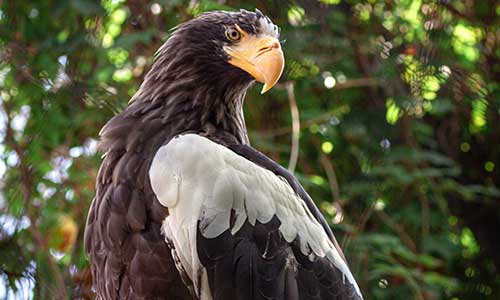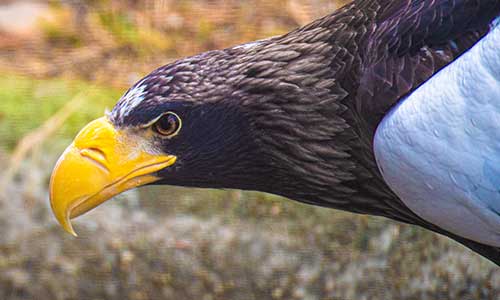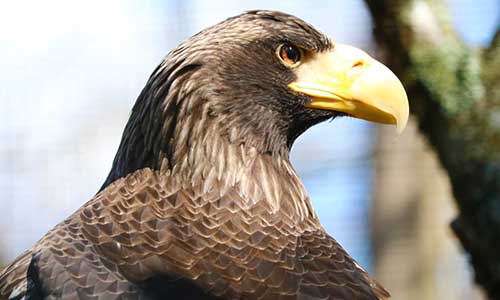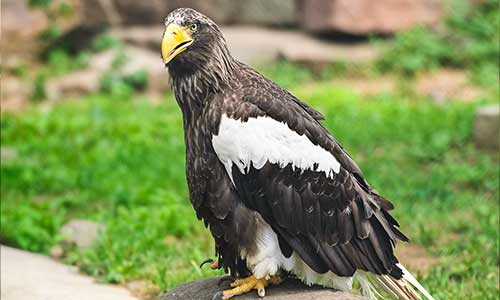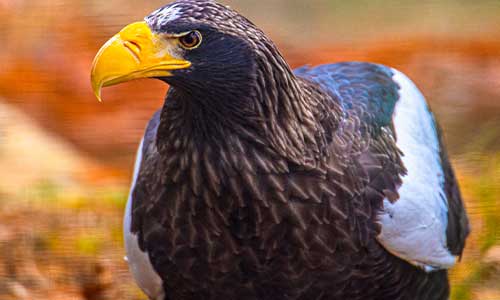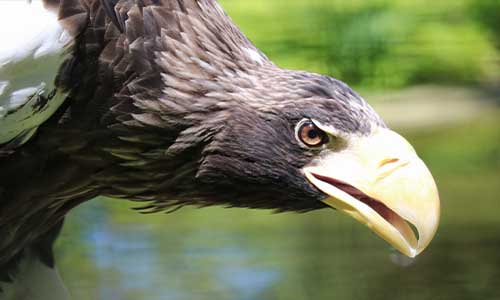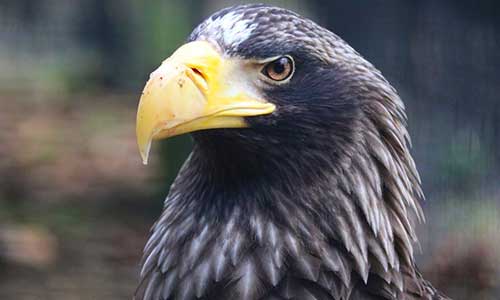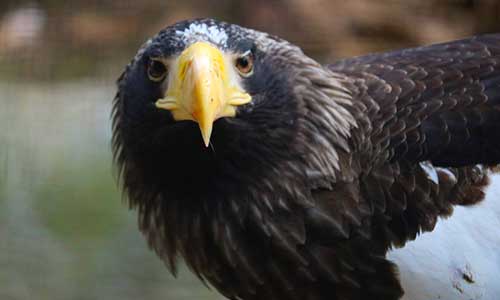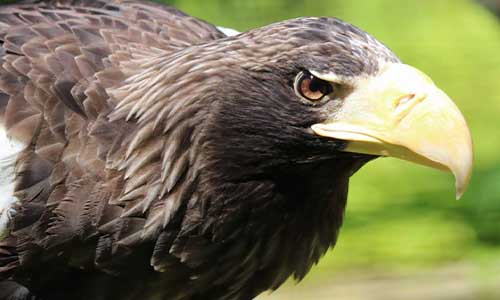Steller's Sea Eagle
Haliaeetus pelagicus
About the Steller's Sea Eagle
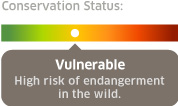
Geographic Range:
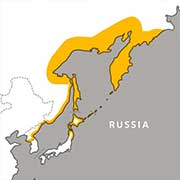
Class: Aves
Order: Accipitriformes
Family: Accipitridae
Genus: Haliaeetus
Species: pelagicus
Steller's sea eagles are the largest of all sea eagles, and the heaviest known eagle. Sea eagles are considered the most powerful and aggressive of their closest relatives, the bald eagle and the white-tailed sea eagle. Sea eagles are diurnal (active during the day). They can hunt from a perch or from flight, diving more than 100 feet or swooping down and catching prey in their talons.
Steller's Sea Eagle
Appearance:
The sea eagle has a dark body and strongly arched yellow bill. Its forehead, shoulders, thighs and tail are white. Sea eagles are most closely related to white-tailed eagles, bald eagles, harriers, kites, and goshawks.
Size:
Steller's sea eagles are the largest of all sea eagles, and the heaviest known eagle.
- Length: 34 - 41 inches
- Weight: Females, 13-20 pounds; males, 10-15 pounds
- Wingspan: Up to 8 feet
Diet:
Steller's sea eagles are fish-eating raptors, mainly consuming salmon and trout. They'll eat all sources of protein—dead or alive—including puffins, fish, crabs, and even deer carcasses when food is harder to find. Like other eagles, Steller’s sea eagles will steal food from other birds.
Reproduction:
Sea eagles are sexually mature at 5 years of age. Courtship occurs during late winter, and females start laying greenish-white eggs in mid-spring. Pairs typically return to the same nest site each year. They typically lay one to three eggs, but usually only one chick survives. Incubation lasts 39 to 45 days. Eaglets have downy gray-white feathers that gradually change to brown. By the time they're five weeks, eaglets eat approximately one pound of fish daily. Eaglets fledge around 10 weeks of age.
Behavior:
Steller's sea eagles are considered the most powerful and aggressive of their closest relatives, the bald eagle and the white-tailed sea eagle.
Eagle vision can reach up four to five times further than a person with perfect vision. Eagles use both monocular and binocular vision, meaning they can use their eyes independently or together depending on what they’re looking at. They also have superior color vision, and can see ultraviolet light, which allows them to follow urine trails from prey. Sea eagles spend most of their days perched on sea cliffs using their “eagle eyes” to hunt for prey.
Sea eagles are diurnal (active during the day). They can hunt from a perch or from flight, diving more than 100 feet or swooping down and catching prey in their talons. They’ve been known to stand in shallow water, snatching fish as they pass. Like other raptors, sea eagles clamp onto their prey with their sharp talons, not releasing their catch until it’s dead. Their large, powerful bill is adapted to tearing at flesh.
Due to the remote nature of their habitat, little is known about the phase from fledging and the first winter migration until birds reach sexual maturity. It's possible that sea eagles may not even breed until much later.
Nests (or aeries) are built high in dead or open-topped trees near rivers or shorelines, or on rocky cliffs, up to 100 feet above ground. Aeries are massive, and they may sometimes contain 400 or more large branches. They're between six and eight feet wide and weigh hundreds of pounds.
Habitat/range:
Their primary habitat is the rocky seacoasts and rivers of far eastern Russia, along coasts and surrounding islands of the Sea of Okhotsk and Bering Sea. They're most common on the Kamchatka Peninsula. Migrating eagles may go as far south as the southern Kuril Islands and to Hokkaido, Japan.
Median Life Expectancy:
Unknown in the wild, but the Steller's sea eagle's longevity is thought to be similar to its relative, the white-tailed eagle, whose lifespan is 20-25 years.
Conservation:
This rare and vulnerable bird has been given complete legal protection in Russia, the only place it breeds, and in Japan, where it overwinters.
Habitat loss due to the development of hydroelectric power projects and logging, overfishing and contaminated rivers are some of the many threats facing Steller’s sea eagles. Overfishing has caused eagles to scavenge carrion filled with lead, which has had devastating effects on the population. Japan’s Hokkaido Island has outlawed lead ammunition as a result. In 2009, the population was estimated at 5,000 birds and declining.
What you can do:
Know where your seafood comes from, and choose sustainable sources.
Fun Facts:
- The Steller’s sea-eagle was named for a noted 18th-century zoologist and explorer, Georg Wilhelm Steller.
-
Sea eagles are especially revered in Japan, where they're known as O-washi, meaning “The Great Eagle.”
You Can Find This Animal in the Raptor Ridge
Eagle's Eye
Eagles use both monocular and binocular vision, meaning they can use their eyes independently or together depending on what they’re looking at, keeping an "eagle's-eye" view on their prey.
You May Also Like
At Franklin Park Zoo:
At Stone Zoo:

